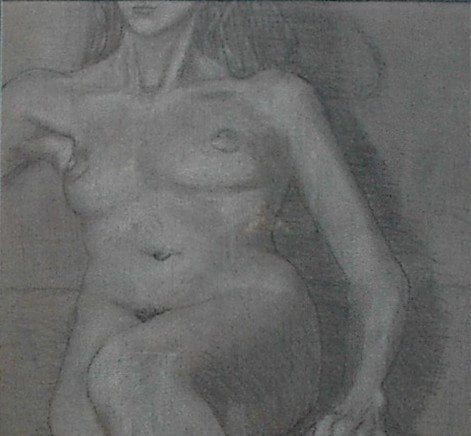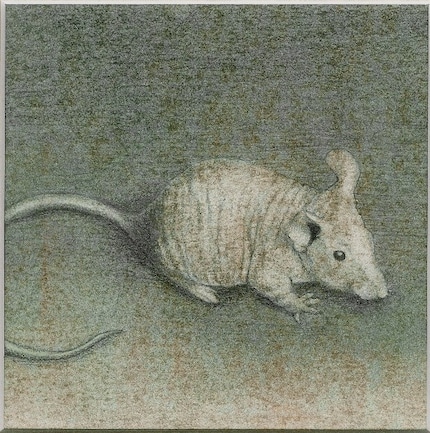
I decided to start with a medium that was near and dear to my heart. This technique was invented in ancient times, was revived during the Renaissance by the great masters, and then revived again in more modern times by late 20th century artists such as Picasso and Joseph Stella.
Silverpoint (broadly referred to as Metalpoint) uses a thin silver wire (usually Fine Silver, which is 99.9% silver, or Sterling Silver, which is 97.5% silver) to draw very delicate, fine lines on a specially prepared surface. The technique is not limited to silver, as I have used 22K gold wire and pure copper wire, and in ancient times, lead, bronze and possibly other metals were used. This thin metal wire is usually wrapped with or around something so the artist can hold onto it better while drawing. Historically, the wire could be wrapped around a pencil or stick, allowing only the tip to extend out past the end. In my own experience, I use modern mechanical pencil holders, as they come ready to accommodate a variety of widths.
The specially prepared surface (support) can be virtually anything--canvas, wood, parchment--but is most commonly paper. Whichever support is chosen must then be treated with a primer to give the paper some "tooth" (grittiness). In ancient times, this primer was a mixture of binding agent (think something sticky--gum arabic, spit, other stuff that is even more nasty sounding) and white pigment (could be anything--ground up bone, chalk, ashes). In modern times, artists generally use common gesso, an acrylic-based primer. This painted surface can be sanded gently with very fine sandpaper to eliminate brushstrokes.
Once the artist has prepared a metal wire he or she can hold onto, and has a prepared surface, all that is left to do is start drawing. The fine lines on the page resemble the marks made by a very hard pencil, and must be built up gradually to reach the desired darkness. Generally, crosshatching, laying down many tiny parallel lines in different directions across one another, is the best way to create shading. These lines will be very silvery and even show a bit of metallic appearance at first, but over time, the metal will oxidize upon exposure to the open air and turn dark and a little brownish, as can be seen in Rembrandt's portrait of his wife at the top.

Newer metalpoint drawings will appear silvery or like they were drawn with a very hard pencil. The drawing at the right is an example of a metalpoint (silver and gold) that I made a few years ago. This drawing will probably take a long time to oxidize, as it is already framed under glass, and it currently hangs in my home, in the middle of the desert. The speed at which oxidation takes place can depend on all sorts of things, like moisture in the air, pollution, salty air. I have read about techniques to accelerate the process using dilute egg yolk solution, or an acidic solution, but have never tried any of them (so much work goes into a drawing, I can't stand the thought of ruining one).
So, the next question that comes to most people's minds is, if this technique looks so much like pencil drawing, why do it? There are a variety of good reasons. The fine lines you can obtain from this technique are much finer than those you can achieve with a pencil. Another huge advantage to the artist is that these fine lines won't smudge! (Well, okay, I've gotten them to smudge a tiny bit, but only on purpose.) Granted, because they don't smudge, lines are very difficult (but not impossible) to erase, but since most markings are built up from many small lines, you can make a few stray wrong marks with little harm. The final reason that I can think of is the durability of the medium. Drawings in metalpoint should last for at least as long as a pencil drawing, and the primer on the paper will help prevent the drawing from getting crumpled or bent.
So are you all ready to try it for yourself? Go to this great site to find all of the expert advice, detailed history, and even supplies you will need to get started!

 From this prepared surface, you will create all of the lights, darks and midtones using three tools: graphite pencil (6B to 9B, very soft), a kneaded rubber eraser, and a wad of tissue. The pencil is used to create any tones darker than the paper tone, using crosshatching or other techniques to achieve the darkness you desire. The kneaded rubber eraser is used to gently lift out the pastel colors to create the highlight areas, and you are able to lift out as much as you please, from a little lighter to all the way back to white. The wad of tissue acts as sort of another type of eraser, but this one helps blend unwanted lights or darks back to the background midtone.
From this prepared surface, you will create all of the lights, darks and midtones using three tools: graphite pencil (6B to 9B, very soft), a kneaded rubber eraser, and a wad of tissue. The pencil is used to create any tones darker than the paper tone, using crosshatching or other techniques to achieve the darkness you desire. The kneaded rubber eraser is used to gently lift out the pastel colors to create the highlight areas, and you are able to lift out as much as you please, from a little lighter to all the way back to white. The wad of tissue acts as sort of another type of eraser, but this one helps blend unwanted lights or darks back to the background midtone.  For my second installment of Artistic Media You May Have Never Heard Of, I have chosen embossed prints. A striking example of this medium is shown in the banner at the top of this blog. This medium comes under the category of printmaking because the image is transferred to the paper by running a plate of some sort through a press with a piece of damp paper. If you would like to read more about printmaking in general, please go to my lens on
For my second installment of Artistic Media You May Have Never Heard Of, I have chosen embossed prints. A striking example of this medium is shown in the banner at the top of this blog. This medium comes under the category of printmaking because the image is transferred to the paper by running a plate of some sort through a press with a piece of damp paper. If you would like to read more about printmaking in general, please go to my lens on 
